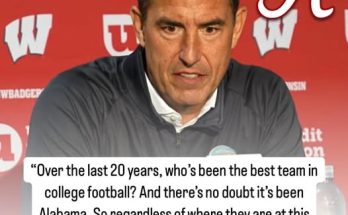After two weeks of action in the 2025 college football season, LSU fans and analysts alike are turning their attention to the Tigers’ quarterback situation, with Garrett Nussmeier firmly in the spotlight. Nussmeier, who has carried the starting responsibilities into this season, has drawn both praise and criticism in equal measure, making this a perfect moment for fans to weigh in and assess his performance so far. Evaluating a quarterback’s output early in the season is always challenging, but by examining Nussmeier’s statistical production, decision-making, leadership on the field, and adaptability to LSU’s offensive scheme, fans can form a comprehensive view—and share their opinions to spark meaningful discussion.
Starting with the numbers, Nussmeier has shown glimpses of both promise and areas for improvement. In the first two games, he has completed a respectable percentage of his passes, demonstrating accuracy on intermediate throws while occasionally struggling with deep ball consistency. While some may point to a modest touchdown-to-interception ratio, it is important to remember that LSU’s offensive line has faced heavy pressure, and receivers are still developing chemistry with the quarterback. Evaluating these statistics in context provides a more nuanced understanding than simply glancing at raw numbers. Fans who follow each snap closely can often detect subtle improvements in timing and pocket awareness that may not show up in the box score, and these details are worth discussing with fellow supporters.
Beyond numbers, Nussmeier’s decision-making has been a key area of focus. In high-pressure moments, he has shown a willingness to take calculated risks, threading the ball into tight windows and exploiting defensive mismatches. At times, however, he has made decisions that cost the Tigers yardage or stalled drives, highlighting the learning curve that even talented quarterbacks experience in the SEC. This balance of risk and caution is where fans’ perspectives are particularly valuable. Engaging in conversations about whether Nussmeier’s decision-making reflects growing confidence or over-aggression can lead to rich debates. Observers might point out specific plays where he displayed poise under pressure, or conversely, moments where hesitation or misreading coverage led to turnovers, creating a dynamic discussion environment.
Leadership is another critical component of Nussmeier’s early-season evaluation. As the starting quarterback at a program like LSU, he is expected to command the huddle, inspire teammates, and maintain composure even when games do not go according to plan. In the first two weeks, Nussmeier has demonstrated signs of strong leadership, particularly in his communication with wide receivers and his ability to adjust plays at the line of scrimmage. Fans often notice these intangibles more than casual viewers do, making their insights invaluable. Encouraging people to share examples of leadership moments they observed—whether it’s motivating the team after a turnover or maintaining focus in a close contest—can deepen engagement and help everyone appreciate the multifaceted role of a quarterback.
Adaptability is another key factor that cannot be overlooked. LSU’s offensive scheme may require the quarterback to adjust quickly to new formations, defensive fronts, and play-calling sequences. Nussmeier’s ability to read defenses, audibilize effectively, and respond to pressure is essential for long-term success. In the early part of the season, he has shown flashes of adaptability, particularly on plays where he had to extend the pocket or change his read based on coverage shifts. Fans who analyze game film often notice these adjustments, and sharing their observations can enrich the community’s understanding of the quarterback’s capabilities. Conversations around how Nussmeier adapts to blitzes, coverage schemes, or fast-tempo defenses can reveal insights that casual viewers might miss, making engagement more meaningful.
It’s also worth considering Nussmeier’s connection with his receivers. Chemistry between a quarterback and his targets often determines the success of the passing game, especially in a high-powered offense like LSU’s. In these first two weeks, Nussmeier has built rapport with several key receivers, timing routes well and displaying the ability to put the ball in positions where it can be caught in stride. Some passes, however, have been slightly off-target or mistimed, creating opportunities for discussion among fans. By examining how his accuracy aligns with receiver separation, route execution, and defensive coverage, the audience can form opinions on whether these early-season results are indicative of growing synergy or areas that need continued focus.
Of course, no evaluation is complete without considering the context of the opposition. Nussmeier’s performance must be weighed against the defenses LSU has faced in the opening games. Were the opponents known for strong pass rushes, tight coverage, or bend-but-don’t-break defensive strategies? How did Nussmeier respond when facing adversity? These questions provide fertile ground for discussion, encouraging fans to compare his performance against expectations and previous LSU quarterbacks. Engaging in these comparisons can be enlightening, as fans bring different perspectives, historical knowledge, and analytical insights to the table. It also allows for debate about how well-prepared Nussmeier is to handle the rest of the SEC schedule, which will likely feature some of the toughest defensive units in college football.
Another element to consider is Nussmeier’s mobility. In modern football, a quarterback’s ability to make plays outside the pocket adds a crucial dimension to the offense. So far, he has demonstrated athleticism in scrambling for first downs or avoiding pressure, but fans might debate how effectively he balances mobility with maintaining vision downfield. Observing and discussing these moments can highlight Nussmeier’s potential to create plays under duress, as well as opportunities for growth in decision-making when moving away from the pocket. Fans who enjoy dissecting the mechanics of quarterback play often have unique insights into how mobility contributes to overall efficiency, making their commentary valuable to the broader discussion.
Encouraging visitors to comment on Nussmeier’s early performance can foster a vibrant, interactive community. By sharing opinions, highlighting plays, or debating key decisions, fans contribute to a richer understanding of the quarterback’s abilities and the team’s trajectory. Questions like “Which play from the first two games best exemplified Nussmeier’s potential?” or “Where does he need to improve the most before facing tougher SEC defenses?” are excellent prompts that invite responses and differing perspectives. This type of engagement not only benefits individual participants but also helps create a repository of thoughtful analysis for the entire LSU fanbase.
It is also important to recognize that early-season evaluations should not be overly definitive. Two games provide a snapshot, but a full season offers a broader and more accurate assessment. Encouraging measured discussion—acknowledging both positive contributions and areas for growth—helps avoid overly harsh criticism or unwarranted praise. Fans can engage constructively by noting improvements, predicting how Nussmeier might respond to future challenges, and comparing his performance to expectations based on preseason scouting reports. By fostering an environment where opinions are backed by observations and context, the discussion becomes educational and insightful, appealing to a wide range of LSU supporters.
Furthermore, evaluating a quarterback is as much about the narrative as it is about numbers. Fans love storytelling: describing a clutch throw, a perfectly executed read, or a moment of poise under pressure brings the player to life beyond statistics. Inviting readers to share their favorite moments from Nussmeier’s first two games creates engagement rooted in experience and emotional connection. This personal aspect of football analysis can lead to passionate commentary, lively debate, and even some friendly rivalry among fans, all of which strengthen the community around LSU football.
Another angle for discussion is Nussmeier’s potential trajectory for the remainder of the season. Fans might speculate about how he could develop chemistry with younger receivers, how his comfort level in the offense will evolve, or how he will respond to midseason adjustments by opposing defenses. Encouraging predictions and scenario-based discussions can spark creativity and keep engagement high, as fans weigh possibilities and explore “what if” questions. It’s a chance for everyone to contribute insights and feel invested in the quarterback’s journey, making the evaluation both interactive and dynamic.
In addition, comparing Nussmeier’s early performance with historical LSU quarterbacks can be an engaging exercise. Fans often enjoy debating where a current player stands relative to past greats, taking into account differences in offensive philosophy, competition, and supporting cast. Asking visitors to weigh in on these comparisons can elicit passionate responses, deeper analysis, and even nuanced discussion about the evolution of the quarterback position at LSU. It also gives fans an opportunity to celebrate past players while contextualizing Nussmeier’s current achievements.
Finally, encouraging engagement on this post can go beyond simply evaluating plays. Fans can discuss broader themes such as leadership, resilience, adaptability, and the impact of coaching decisions on Nussmeier’s performance. These conversations elevate the discourse from purely statistical analysis to a more holistic understanding of the player and his role within the team. By sharing observations, insights, and opinions, readers can collectively create a detailed portrait of Nussmeier’s first two weeks, providing a valuable resource for anyone following LSU football this season.
In conclusion, Garrett Nussmeier’s first two games as LSU’s starting quarterback have provided plenty to analyze, celebrate, and critique. From statistical production to decision-making, leadership, adaptability, chemistry with receivers, and mobility, every aspect of his game invites thoughtful evaluation. Encouraging fans to share their perspectives not only enriches the conversation but also strengthens the LSU community as a whole. By engaging with this post, readers can debate plays, highlight strengths, discuss areas for improvement, and predict how the quarterback might develop as the season progresses. Every opinion adds to the conversation, and every observation helps paint a fuller picture of Nussmeier’s early-season performance. The first two weeks are just the beginning, and there’s no better time than now for fans to weigh in, share their thoughts, and become active participants in evaluating one of LSU’s most exciting players.
So, whether you’re impressed by his poise in the pocket, curious about how he will adjust to tougher defenses, or have questions about specific plays, your input matters. Drop your thoughts, highlight your favorite moments, and let’s collectively break down Garrett Nussmeier’s early-season performance. Every comment, every perspective, and every debate makes the discussion richer—and that’s what makes following LSU football truly special. Your insights can spark dialogue, challenge assumptions, and ultimately help fans across the country appreciate the nuances of one of college football’s rising talents.



